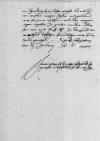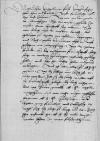Dem durchlauchten, hochgebornen fursten und hernnn, hern ⌊Albrechten⌋, von Gots gnaden marggraff zu ⌊Brandenburgk⌋, / in ⌊Preussen⌋, zu ⌊Stetin⌋, ⌊Pomern⌋, der ⌊Cassuben⌋ und ⌊Wenden⌋ hertzog, burggraff zu ⌊Normberg⌋ und furst zu ⌊Rugen⌋, / unserm hochgunstigen, lyben hern und freundt
Durchlauchter, hochgebornerr furst, hochgunstigerr, lyber herr und freundt. / Unser freuntliche, wyllige dinst zuvoran. /
Wÿ wir von den gnaden des almechtigen mÿt den unsern gesundt in unsere ⌊newe herschafft⌋ sein ankomen, / seÿ wir durch vyl der unsern bericht / dess thodtslages, so ⌊Mattes von Elditten⌋ begangen / und noch vÿler demuetiger bytt, an unss geschenn, / mit antzeÿgung, / wÿ das theters freunde / beÿ des erslagenen freuntschafft / solche sache in vortrag zu bringen vÿlmals gesucht haben / und bys her nichts haben mugennn erlangen, / und yst alein alles zu Ewer Furstlichen Durchlaucht gestaldt, / wÿ dÿ selbtige nun auch ÿst ersucht worden. / Hatt sy dÿ sache weÿtter uff dÿ freuntschafft gelegt, / dÿ doch nichts anders, wÿ zuvor gemeldt, Ewer Durchlaucht wyllen nachgehenn, / hab wir nicht mugen nachlassen, hirynnen Ewer Furstliche Durchlaucht zubesuchen. / Und bÿtten gantz freuntlich und vleÿssig, / dÿ weÿl sich dÿ sache so lange, nun bis in zweÿ jhar, erstreckt hat, / Ewer Furstliche Durchlaucht wolle dem genanten ⌊theter⌋ in yrem ⌊furstenthumbe⌋ / ein christlich, freÿ, sicher geleydt ab und zu von unsern wegen leÿsten und gebennn, / uns hirynne wÿlforen / und den ungenedigen wyllen in gnaden wenden. / Das sein wir umb Ewer Furstliche Durchlaucht, in der gunst wir un[s] thun befelhen, freuntlicher weis zuvordynen geneÿgt. /
Datumm ⌊Heÿlsberg⌋, den III Ianuarii M D XXXVIII.
⌊Ioannes⌋, von Gots gnaden colmischer byschoff, administrator zu ⌊Pomesan⌋ und postulirt zu ⌊Ermelandt⌋


